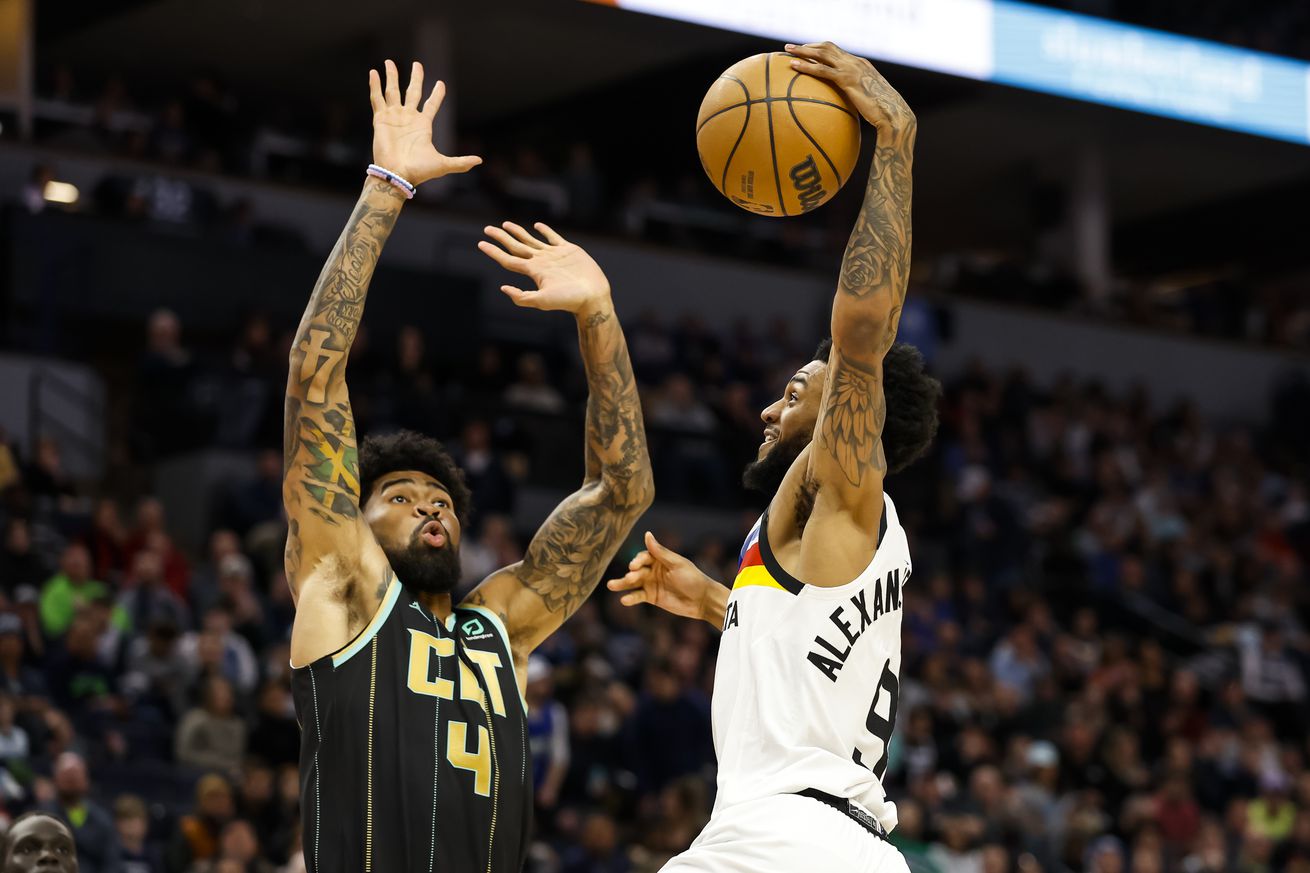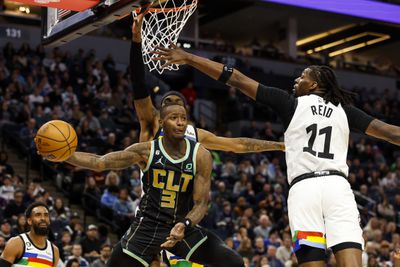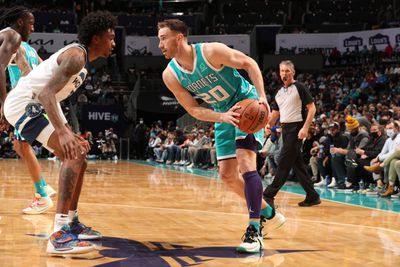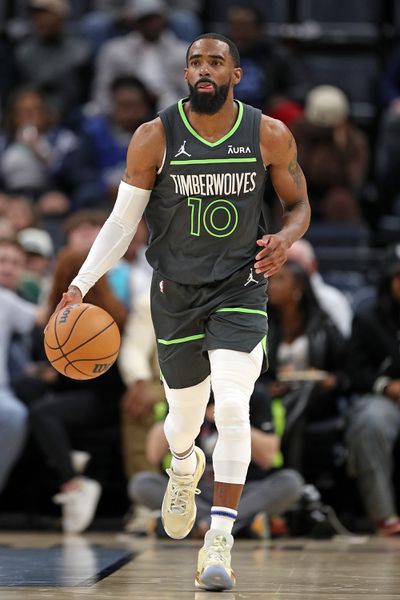
Karl-Anthony Towns and the Timberwolves hit the road for a one-game stop in Charlotte against Terry Rozier and a Hornets squad playing without LaMelo Ball.
The Minnesota Timberwolves head to the Queen City in hopes of maintaining their hot form against a depleted Charlotte Hornets team. Both teams are missing their young stars, so there should be ample opportunities for role players to step up and take on prominent roles.
Game Info
- Who: Minnesota Timberwolves (14-4) at Charlotte Hornets (6-11)
- When: 4:00 PM CT
- Where: Spectrum Center
- TV: Bally Sports North (Michael Grady, Jim Petersen and Lea B. Olsen)
- Radio: Wolves Radio App, KFAN FM 100.3
- Line: Timberwolves -6, Total: 221.5 (courtesy of DraftKings Sportsbook)
Injury Report
Updated as of 2:00 PM CT Friday:
Minnesota
DOUBTFUL:
- Anthony Edwards (right hip pointer)
OUT:
- Jaylen Clark (right achilles tendon rupture rehab)
- Jaden McDaniels (right ankle sprain)
- Jordan McLaughlin (right MCL sprain
- Leonard Miller (G League assignment)
Charlotte
QUESTIONABLE:
- Brandon Miller (left ankle sprain)
- Nick Richards (concussion protocol)
OUT:
- Amari Bailey (two-way contract)
- LaMelo Ball (right ankle sprain)
- Cody Martin (left knee injury recovery)
- Frank Ntilikina (left tibia displaced fracture)
What to Watch For

Photo by David Berding/Getty Images
Turning Defense into Offense
The Timberwolves haven’t been a high-volume transition offense this season, but they have been one of the most efficient. Per Cleaning the Glass, Minnesota ranks just 15th in transition frequency (15.1%), but they rank first in transition points per play with 1.476 and first in points added per 100 possessions with 5.7. The Wolves ranking even 15th seems high and a main reason for that is due to them not pushing after defensive rebounds. In these situations, they turn only 25.3% of their defensive rebounds (26th) into transition possessions but rank ninth in points per play.
Where the Timberwolves have found extraordinary success, though, is off of steals. The Wolves are currently turning 69.9% of their steals into transition possessions (7th) and rank first in points per play (1.839) and first in points added per 100 possessions (4.1) in these situations. Against the Utah Jazz, we saw how quickly players like Nickeil Alexander-Walker can spark the offense through their defensive play.
While the Timberwolves likely won’t look to push too aggressively off of defensive rebounds, there should be plenty of opportunities off of steals as the Hornets allow the sixth most possessions in these scenarios. The Hornets also rank 18th in turnover rate. Unfortunately for the Wolves, one of the biggest culprits of lackadaisical ball security was LaMelo Ball who had a turnover rate of 13.7% (22nd percentile). However, Ish Smith, who has been thrust into a more prominent role due to injuries, has a turnover rate of 26.3% (0 percentile). With Terry Rozier likely getting the start, it will be important for the Timberwolves to apply ample pressure to the second unit ball-handlers to create easy buckets in transition.

Photo by Kent Smith/NBAE via Getty Images
The Hornets’ Curious Shot Selection
When we look at a team’s shot selection frequency, it typically aligns with what they’re good at. Teams who shoot well in the midrange tend to take more midrange shots than those who aren’t. Similar philosophies with shots at the rim and from three. The Hornets don’t necessarily abide by that ideology, though. In fact, they almost do the exact opposite.
The Hornets have a pretty diverse shot chart as they take 38% of their shots at the rim (third), 31% in the midrange (17th), and 31% from deep (28th). What is fascinating is that their shot accuracy rankings are almost the inverse of their frequency ratings. The Hornets are currently shooting 63.9% at the rim (24th), 40.7% in the midrange (26th), and 37.2% from 3 (13th). Despite having five players shooting at least 38% and ranking above the 50th percentile from beyond the arc (one of whom is Ball), the Hornets simply don’t take that many treys.
Focusing on attacking the rim isn’t a bad thing at all, as it’s the best shot in basketball. However, generating quality looks at the rim is more important than just simply forcing a square peg into a round hole. The Hornets seem to be doing the latter. Charlotte has eight players who rank in at least the 60th percentile in at-rim shot frequency at their position and four who rank in at least the 90th percentile. However, they only have four who rank in at least the 50th percentile in at-rim shooting accuracy.
Of those four, one is Nick Richards who is mostly a lob threat and only plays 16.4 minutes, one is Ish Smith who a complete non-shooting threat, one is Gordon Hayward who ranks in the 50th percentile in at-rim frequency and has turned into more of a midrange operator, and the other is Brandon Miller who had significant questions about his interior scoring ability coming out of college (looks like those were overblown, shocker). The long and short of it is that their offensive decision making is peculiar and fits nicely with how the Timberwolves tend to defend.
The Wolves have been one of the best teams in the league at protecting the rim. They have the fifth best defensive field goal percentage and allow the second fewest shots. Minnesota tends to funnel everything to the midrange as they rank 28th in defensive midrange shot frequency, but they defend it well as they rank fourth in defensive midrange shooting accuracy. As long as the Timberwolves execute their assignments and play together like they did against the Jazz, they should be able to lock down this Hornets offense barring an outburst from Rozier, which we’ve seen before.

Photo by Justin Ford/Getty Images
Be Patient in the Half Court
The Timberwolves’ half-court offense has been underwhelming this season (18th), and it can get bogged down even more without Anthony Edwards. The Hornets’ half-court defense, though, has been even worse (27th). As long as the Timberwolves are patient and pick their spots, they shouldn’t have any issues getting quality looks.
The Hornets have been terrific at limiting midrange shots this season, which has been one of the calling cards of the Wolves’ offense. Instead, the Hornets are allowing a ton of shots at the rim and from three while ranking 22nd and 27th in defensive field goal percentage respectively. Minnesota currently ranks 16th in at-rim field goal percentage and 5th from three.
When the Timberwolves’ offense has been at its best is when ball-handlers have actively attacked the lane and found teammates out of the drive. These actions create movement and confusion amongst the defense and generate quality looks from three or at the rim. As the Wolves penetrate the lane, there should be ample opportunities to throw a back door lob or kick out to open shooters. If the offense gets stagnant and they routinely have possessions with two or fewer passes, though, this game could quickly devolve into a rock fight.